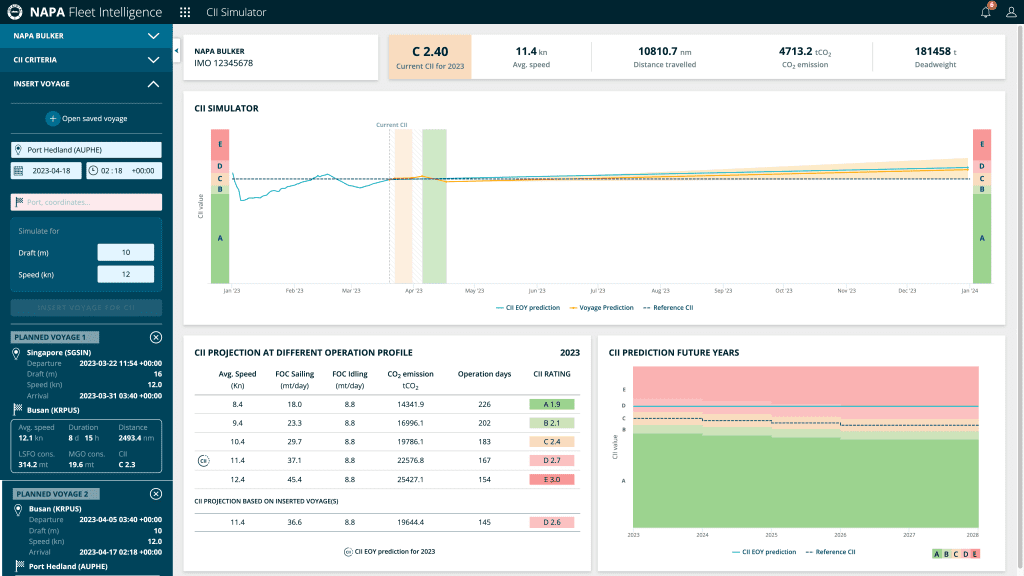CII in practice: The value of being proactive
Welcome to the CII era, where a ship’s operational carbon efficiency will impact its competitiveness and business prospects. While much uncertainty remains, the good news is that the technology and practical tools needed to enable shipowners and charterers to successfully manage their CII already exist in the form of simulation and data analysis tools. The sooner they act, the better off they will be – so here’s where to start.
In the broad shipping decarbonization debate, the benefits of reducing the carbon footprint of ships have often been eclipsed by discussions about new fuels. But as UMAS concluded in its recent report “How can international shipping align with 1.5°C?”, most of the absolute emission reductions required this decade can be unlocked with improved energy efficiency. In other words, we know that clean technologies and voyage optimization are essential to achieve shipping’s decarbonization ambitions, now and in the long term.
In the near term, a pressing incentive comes from international regulation, with the entry into force of the IMO‘s Carbon Intensity Indicator (CII). Since January 1st, 2023, every sea passage and every unit of carbon emitted are building toward a vessel’s final score for the year – under a rating system that is intended to favor efficient ships going forward.
For shipowners and charterers, this already raises some fundamental questions, chiefly:
- Is the ship on the right track to be compliant with CII requirements at the end of the year?
- What measures and when should I take to have a real impact on the vessel’s CII?
Answering those questions today will help companies take control of their CII and make smart choices throughout the year to ensure compliance in a way that works for their business. This will enable them to make minor adjustments for a longer period of time, rather than having to take drastic action in the last months of the year by reducing speed significantly, for example, which would have a bigger impact on the ship’s competitiveness.
The case for a proactive approach to CII is clear – and with simulation and data analysis tools, the technological groundwork has already been built to make it happen.
How can we make CII work in practice?
The CII era is shifting some of shipping’s most enduring paradigms – redefining the relationship between owners and charterers by demanding an unprecedented level of collaboration.
If we are to make CII a success, owners and charterers need to work together more closely to reduce a vessel’s emissions and ensure its compliance. This is because responsibilities and incentives are shared: owners will be on the receiving end of a good or bad CII rating, yet it is largely outside their control as they only have indirect means to impact CII from ship operations. Meanwhile, for the first time, charterers could have a contractual obligation to operate the vessel energy-efficiently under the BIMCO clause or other agreements.
To make this collaboration a reality, we need trust between owners and charterers – and the foundation for this trust is digital! In essence, both parties need a neutral, objective platform where they can develop a shared understanding of how a vessel’s CII evolves throughout the year and what can be done to improve or maintain it. This is where simulation and data analysis tools come in.
How is NAPA supporting the industry?
Working in collaboration with owners and charterers and responding to their demand for solutions to manage their CII proactively, we developed our NAPA CII Simulator module, part of the NAPA Fleet Intelligence platform. The aim is to deliver reliable analyses and predictions that help ship owners and charterers make the best possible operational decisions together to improve the ship’s performance and boost or maintain its CII.
The NAPA CII Simulator uses a ship’s digital twin, together with data on its past and current routes and performance, to predict its CII rating for every sea passage or any desired date during the year, such as at the end of the year, or after a given chartering period. Crucially, the software can simulate the impact of different energy efficiency measures and operational profiles, such as weather routing, slow steaming, hull cleaning, or installing energy-saving devices, on a vessel’s future rating. This provides owners and charterers with greater clarity on whether they are on track to achieve the agreed CII, and vital insights into what measures will deliver the most impact for a specific ship.
In practice, this enables owners and charterers to compensate for any unexpected events, including bad weather or a less efficient journey, to bring the vessel’s CII back in line with expectations. The tool also helps them identify when they have enough margin to take a hit on CII optimization and seize a business opportunity that would involve a less efficient or faster journey.
Importantly, having NAPA CII Simulator as a trusted, neutral, and objective platform can help prevent or resolve disputes under charter party agreements, which will be particularly important when maintaining a certain CII is part of the contract.

Image 1. Screenshot of NAPA CII Simulator showing the CII prediction of a bulk carrier.
Why start now?
While it is still early days, CII ratings are expected to influence a ship’s competitiveness, meaning that strong environmental performance is likely to impact asset value positively. Pressure will come from both ends of the logistics chain. On the one hand, cargo owners, consumers and ESG-conscious companies will increase demand for sustainable shipping. On the other, top-rated vessels may receive better freight rates, loan conditions and interest rates, or lower insurance costs.
As a result, poorly rated ships may struggle to secure business and financing, while top-rated vessels are likely to have a competitive advantage. This will become apparent, especially starting in 2024, when the first CII ratings will be assigned for the vessels based on 2023 data. And that impact will increase over the coming decades as pressure for decarbonized supply chains grows.
Furthermore, the value of boosting vessel efficiency this decade will extend beyond current regulatory requirements, because any efficiency gains made in the 2020’s will buy precious decision-making time for the adoption of new fuels later, and more efficient vessels will require smaller volumes of these expensive fuels.
In other words, ship owners and charterers who take proactive and collaborative action now to incorporate efficiency gains will have increased control over their own short and long-term decarbonization strategies.
First movers will set themselves at the forefront of this inevitable change. So, even though the industry is currently waiting to see whether the IMO will adopt stricter measures in its revised GHG reduction strategy at MEPC 80 in July this year, there’s no reason to delay. Regardless of the outcome, the benefits of taking a proactive stance on efficiency will be beneficial for ship owners and charterers. At NAPA, we are committed to accelerating the industry’s goal of reaching net zero emissions and believe the path forward need not be set purely by regulation.
Read more from the Press Release announcing the launch of the NAPA CII Simulator.
This blog article was originally published on LinkedIn on June 5th, 2023, by Ossi Mettälä.


